This blog post is based on my presentation at the HOMER International Microgrid Conference last month in Denver. My topic was the role of microgrids in the distributed energy future. — Peter
The future of energy starts with a fundamental transition from a centralized structure dependent on fossil generation to a distributed structure relying mostly on renewable generation. This transition means a large number of small projects instead of a small number of large projects. And HOMER users are the vanguard of this transition.
To ‘fuel’ this future, the grid-connected world can learn a lot of lessons from international (and Alaskan) experience with off-grid and isolated systems, which were the topics of many of the sessions held at HIMC2017. I’m going to talk about 6 such lessons.
#1 A new planning paradigm for renewables and storage
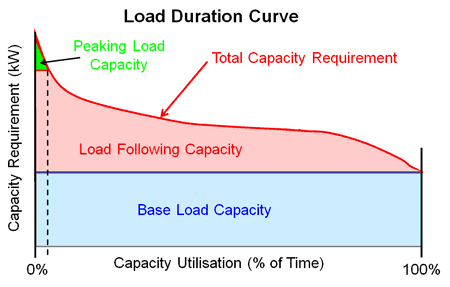
The old paradigm: baseload, load following, and peaking, doesn’t for renewables.
The first lesson to be learned from these off-grid systems is that we need to move beyond the entrenched paradigm of an optimal utility mix being a combination of baseload, load following, and peaking plants. Most of you, I suspect, have seen graphs like this one a million times, and they worked well for designing systems based on thermal resources. But solar and wind are neither baseload, load following, or peaking. The new paradigm is based on a combination of inexpensive renewable electrons and flexible electrons. Today, wind turbines in a good wind resource are the least expensive electrons available. Solar is getting there quickly. Energy from these sources, including their capital cost, compete directly with just the operating costs of coal and nuclear plants.These fuel plants aren’t flexible, and the energy future requires flexibility. So the optimal mix going forward is a combination of renewable resources and flexible resources.
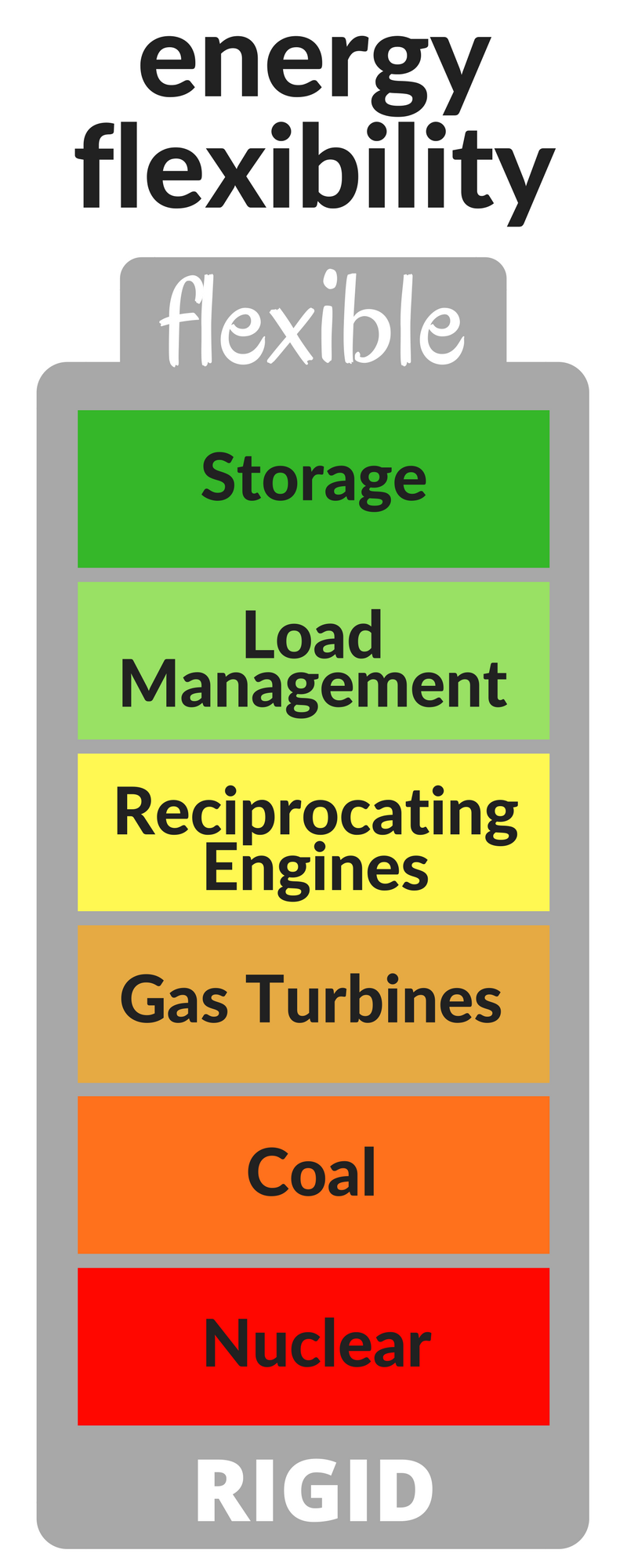
Where do we get flexibility?
The most flexible resource is storage, which in the past has been too expensive, but that is changing quickly. Although storage does compete with peaking plants, it is quite different and its reliability, resilience, and locational flexibility have a lot more value than just providing peaking power. Load management can also be very flexible but requires a lot of communication and control. We work a lot with reciprocating engines, whether fueled by diesel or gas. While not as flexible as storage and load management, reciprocating engines start quickly and ramp well. Gas turbines aren’t quite as flexible as reciprocating engines, but they are cleaner and have lower maintenance costs. But coal is very inflexible and nuclear isn’t flexible at all. In fact, the Chernobyl accident was caused by an unauthorized experiment to have the nuclear plant follow load. This switch from thinking about baseload and peaking plants to thinking about what flexible resources do I need to complement the renewable resources turns power planning on its head. The off-grid world knows all about the first three of these resources.
#2: How to do renewables at very high penetrations
Off-grid systems have been providing reliable power with very high renewable contributions for several decades. Storage, load management, and controls more generally have been a key part of their success.
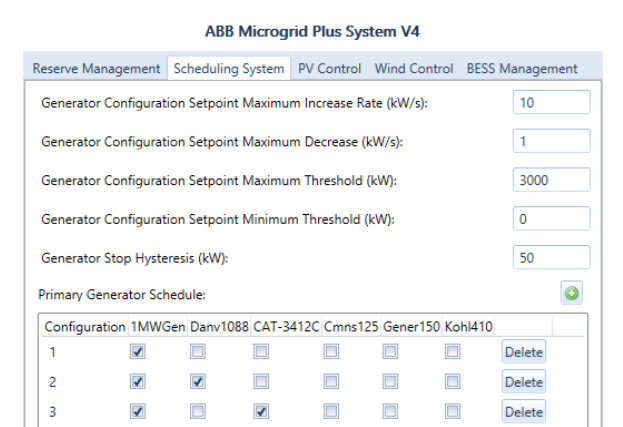
This is a screenshot of ABB’s controller which we are integrating into HOMER Pro and will be available in the next release. Using the Controller API, we can distribute the executable to HOMER users around the world, but our clients have complete control over the user interface.
At HOMER Energy, we understand the need for accurate controller modeling, because controls are so important and such a challenge for the industry. We’ve developed a controller API in HOMER Pro so that you can integrate commercially available control algorithms and create your own control algorithms within HOMER Pro.
#3: Economies of Scale
Another critical lesson to talk about is the role of economies of scale. Economies of project scale have been at the heart of the utility industry from its very beginning. Individual thermal plants have enormous economies of scale, so you want to build them as large as possible. No one even thinks about building small coal plants. While it is true that a utility-scale solar park or storage project is less expensive than smaller, distributed projects, the difference is not nearly as great as it would be for thermal plants.
Solar and storage are really about economies of scale in product manufacturing not in project development. The largest factor in the cost reduction of these technologies has been the construction of large factories that efficiently mass produce these products. There is also a diseconomy of project scale. Only smaller distributed projects can improve service reliability because 90% of service outages are in the transmission and distribution system, so you need your reliability resource on the customer side of the T&D system.
#4 Beyond net metering — the utility death spiral?
The big news in the grid-connected world is the utility industry’s pushback against net metering and promotional feed-in tariffs, which were a great policy to jump-start a new technology. The utilities never thought solar would amount to much, so to make the regulators and the general public happy, they went along with basically being a very large, 100% efficient battery that they didn’t charge for. Now, distributed solar, along with energy efficiency more generally, represents an existential threat to the utility industry as it is currently regulated. As I see it, there are four possible outcomes, most of which are very bad for utility companies. So, if we want to maintain the valuable grid infrastructure we have, how do we avoid this oncoming train wreck?
“As I see it, there are four possible outcomes, most of which are very bad for utility companies. Microgrids are the only solution that I see as win/win.”
The first possible outcome of our current system is that net metering continues as is. The utilities may not lose customers, but they are starting to lose kWh sales. This scenario is often called “the utility death spiral,” as lower kWh sales result in higher rates that encourage more load defection.
The second outcome it that utilities succeed in abolishing incentives for clean distributed energy. This would devastate the distributed solar industry, but it would also devastate the public’s attitudes towards the utility industry. The current debate seems mostly about some zero-sum compromise between these two outcomes, probably including more dependency on demand rates.
A third outcome is that consumers could be forbidden to export power to the utility altogether. We are already seeing this in Hawaii and Australia. The consumer response to this is likely to be smaller solar systems with batteries to absorb excess daytime power. This still doesn’t solve the utility’s challenge of lost revenue from kWh sales.
Microgrids are the fourth solution and the only one that I see that is win-win. As long as consumers are installing batteries they should be allowed to provide services back to the utility. Solar plus storage has many locational and ancillary values that are not recognized by traditional rate treatment. Microgrids can be an interruptible load for the utility and should get similar favorable rate treatment to large interruptible industrial customers. Providing operating or spinning reserves in this way would be much more efficient than keeping fossil generators running inefficiently at low loads. I’ll talk about this solution further under Lesson #5.
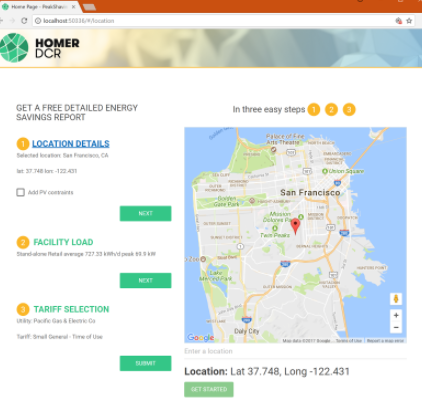 Demand Charge Reducer web app
Demand Charge Reducer web app
Here is a screenshot of a new app we have developed to help our users reduce their demand charges, which we demo’d recently at the HOMER International Microgrid Conference (HIMC2017). To learn more about this product, please visit our Demand Charge Reducer page.
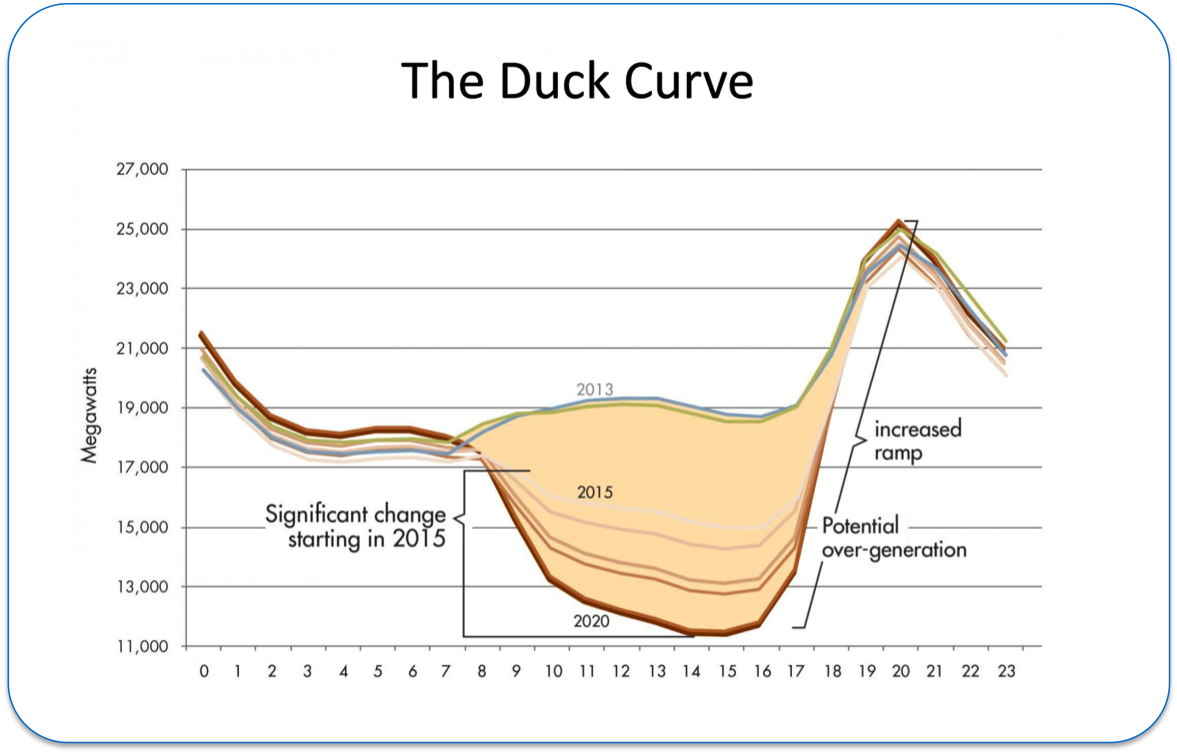
The duck curve graph has been getting a lot of attention lately. It shows the expected net load on a Spring day in California as the amount of solar increases on the grid. There are two big problems that it illustrates. During the belly of the curve, utilities will have a lot of inflexible thermal resources running inefficiently at minimum load, possibly requiring the curtailment of renewable generation with zero marginal cost. They can’t turn off the thermal resources because they will need them as soon as the sun sets. Also, the ramp at sunset will get a lot steeper as it coincides with the pre-existing ramp from lighting and people going home and using power there.
If utilities could rely on microgrids instead of fossil generation for spinning reserve, the belly of the duck curve wouldn’t be a problem. By going off-line for a couple of hours during the steep ramp at sunset, the microgrids could also solve the problem at the neck of the duck curve.
#5 Cost & Value of Reliability
Of course, microgrids would also be valuable to the utility during any system emergency, whether related to extreme weather, terrorism, or just mechanical failures. Lesson #5 is that microgrids really drive home both the cost and the value of reliability. Until now, most people took it for granted, and the utilities provide basically the same level of reliability to everyone regardless of its value to that customer. Microgrids can also help with T&D congestion and frequency and voltage stability. The regulatory system is just scratching the surface of ways to compensate microgrids for all of these services. Instead of distributed solar being a financial challenge to the utilities, distributed solar deployed as a microgrid can make the utility system more efficient, reliable, and resilient.
The utility death spiral would represent a major failure of regulation if these challenges are not addressed, and utility companies lose customers that decide to go completely off-grid. Power will be more expensive for everyone and less reliable for everyone without a microgrid.
 Part of this lesson is that reliable off-grid power is expensive. Understanding that cost is key. HOMER software has been the go-to tool for designing least-cost microgrids for 25 years. This surface plot from HOMER shows the cost of fully off-grid power in a moderate solar resource, such as in New York. The cost varies from 27 cents per kWh in the lower left corner — where we assume $1/watt for the total installed cost of PV and $100 / kWh for the total installed cost of lithium batteries — to 40 cents per kWh in the upper right corner, where those costs are $3 and $300 respectively. The cost of off-grid power would be even higher without a little bit of backup generation.
Part of this lesson is that reliable off-grid power is expensive. Understanding that cost is key. HOMER software has been the go-to tool for designing least-cost microgrids for 25 years. This surface plot from HOMER shows the cost of fully off-grid power in a moderate solar resource, such as in New York. The cost varies from 27 cents per kWh in the lower left corner — where we assume $1/watt for the total installed cost of PV and $100 / kWh for the total installed cost of lithium batteries — to 40 cents per kWh in the upper right corner, where those costs are $3 and $300 respectively. The cost of off-grid power would be even higher without a little bit of backup generation.
That is still much less than the cost of a pure diesel system and close enough to the cost of gas-fired grid power to make grid extensions questionable in many places, but where the grid already exists, it is a valuable asset. Where the grid exists, a grid-connected microgrid that can serve critical loads for a defined period is much less expensive than one that can serve all loads indefinitely. Utilities can align incentives to support the grid and keep customers’ costs below the alternative.
The win-win solution: Turning consumers into prosumers
I want to propose a win-win solution that turns consumers into prosumers and aligns their incentives with the utility. In place of net metering, a solar plus storage microgrid should be able to buy and sell power at approximately the real-time marginal cost of power.
When there is excess power on the grid, such as the belly of the duck or the middle of a windy night, microgrids can charge their batteries or make ice for upcoming cooling needs. In exchange, there will be a fixed charge based on the cost of off-grid power for that customer, so their total cost is no higher than the cost to that consumer of going fully off-grid. Maybe they would be willing to pay a little more for the convenience of having the grid most of the time and the added reliability and resilience of also having their own local power.
When power is expensive and especially in a system emergency, they can cut their consumption from the grid to zero or even support the grid with exports, assuming the grid is functioning.
But what happens when there is an outage and the grid isn’t functioning for an extended period over an entire region, like we just experienced with Irma? There are just not enough fuel trucks to keep all of the simple backup diesel generators in Florida running. So, we end up with tragedies like we saw at the nursing home and that is still ongoing throughout the Caribbean and in Puerto Rico.
Lesson #6: 0 ≠ 0 (net zero isn’t really zero)
My final lesson from the off-grid world is that net zero is really different from real zero. Net zero is a bit of a sleight of hand. Banking excess renewable power with the utility and then drawing it back under net metering later in the day is only possible because the utility has dispatchable fossil generation serving its other customers. Having net zero consumption from the grid is still a great contribution to reducing carbon emissions. I don’t want to sound critical of consumers that have made a commitment to be net zero, but given the need to get so many more people involved in developing large numbers of smaller distributed power project, it is important that the difference between net zero and a true 100% renewable system is appreciated. Likewise, there is a big difference between being able to island a power system for a period of time and having a fully off-grid system.
The off-grid systems that are 100% renewable practice an extreme form of load management. This is relatively easier to do in a microgrid. Or they use a little sleight of hand and say they are 100% renewable except for backup power.
Actually, 97% renewable, such as in Kodiak, Alaska, is really good. That last 3% of fossil generation would be very expensive to get out of the mix and doesn’t really represent significant carbon emissions.
Conclusion
In conclusion, I want to reiterate some of the lessons we have learned from working with microgrids for the past 25 years.
- Very high renewable penetrations are possible and much easier using distributed energy.
- Flexibility is the key to the new power planning paradigm.
- Economies of scale in manufacturing are replacing economies of scale in individual projects.
- We need new rate structures that incentivize prosumers.
- Reliability is valuable and expensive.
- Net metering and net zero are not long-term solutions, microgrids are. And when it comes to renewable penetration, 100% renewable may be a distraction where the perfect is the enemy of the good.
Our mission at HOMER Energy is to help as many people as possible participate in this transition to clean distributed power. Distributed power means many smaller plants, so we need a lot more people engaged with the technologies. That is why we created our Annual HOMER International Microgrid Conference. If you didn’t make it this year, stay tuned to more blog posts over the next few months highlighting illuminating content from HIMC2017 and plan ahead to join us next year for HIMC2018, subscribe to the Microgrid News & Insight newsletter for the latest conference information:
[pardot-form id=”328″ title=”MicroGrid News Subscribe Page Short Version”]
